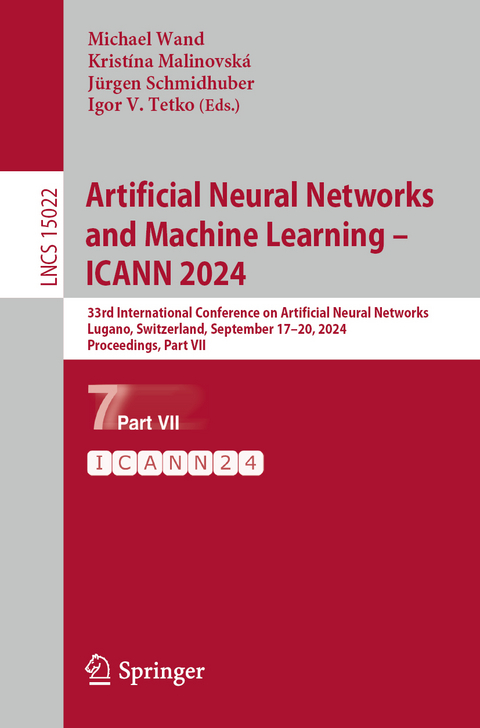
Artificial Neural Networks and Machine Learning – ICANN 2024
Springer International Publishing (Verlag)
978-3-031-72349-0 (ISBN)
The ten-volume set LNCS 15016-15025 constitutes the refereed proceedings of the 33rd International Conference on Artificial Neural Networks and Machine Learning, ICANN 2024, held in Lugano, Switzerland, during September 17-20, 2024.
The 294 full papers and 16 short papers included in these proceedings were carefully reviewed and selected from 764 submissions. The papers cover the following topics:
Part I - theory of neural networks and machine learning; novel methods in machine learning; novel neural architectures; neural architecture search; self-organization; neural processes; novel architectures for computer vision; and fairness in machine learning.
Part II - computer vision: classification; computer vision: object detection; computer vision: security and adversarial attacks; computer vision: image enhancement; and computer vision: 3D methods.
Part III - computer vision: anomaly detection; computer vision: segmentation; computer vision: pose estimation and tracking; computer vision: video processing; computer vision: generative methods; and topics in computer vision.
Part IV - brain-inspired computing; cognitive and computational neuroscience; explainable artificial intelligence; robotics; and reinforcement learning.
Part V - graph neural networks; and large language models.
Part VI - multimodality; federated learning; and time series processing.
Part VII - speech processing; natural language processing; and language modeling.
Part VIII - biosignal processing in medicine and physiology; and medical image processing.
Part IX - human-computer interfaces; recommender systems; environment and climate; city planning; machine learning in engineering and industry; applications in finance; artificial intelligence in education; social network analysis; artificial intelligence and music; and software security.
Part X - workshop: AI in drug discovery; workshop: reservoir computing; special session: accuracy, stability, and robustness in deep neural networks; special session: neurorobotics; and special session: spiking neural networks.
.- Speech Processing.
.- Breaking the Corpus Bottleneck for Multi-dialect Speech Recognition with Flexible Adapters.
.- Developmental Predictive Coding Model for Early Infancy Mono- and Bilingual Vocal Continual Learning.
.- T-DVAE: A Transformer-based Dynamical Variational Autoencoder for Speech.
.- Natural Language Processing.
.- A Generalizable Context-Aware Deep Learning Model for Abusive Language Detection.
.- A Novel Graph Neural Network Based Model for Text Classification.
.- ABSA Methodology Based on Interval-enhanced Talking-heads Attention Network.
.- An Evaluation Dataset for Targeted Sentiment Analysis in Long-Form Chinese News Articles.
.- Anti-Hate Speech Framework: Leveraging Hedging Hyperbolic Learning.
.- Combining Data Generation and Active Learning for Low-Resource Question Answering.
.- CoT-BERT: Enhancing Unsupervised Sentence Representation through Chain-of-Thought.
.- EKD: Effective Knowledge Distillation for Few-Shot Sentiment Analysis.
.- End-to-End Training of Back-Translation Framework with Categorical Reparameterization Trick.
.- Enhancing Zero-Shot Translation in Multilingual Neural Machine Translation: Focusing on obtaining Location-Agnostic Representations.
.- Generative Sentiment Analysis via Latent Category Distribution and Constrained Decoding.
.- Improve Shallow Decoder Based Transformer with Structured Expert Prediction.
.- KELTP: Keyword-Enhanced Learned Token Pruning for Knowledge-Grounded Dialogue.
.- Knowledge Base Question Generation via Data Augmentation with Dynamic-prompt.
.- Lifelong Sentiment Classification Based on Adaptive Parameter Updating.
.- Multi-stage vs Single-stage: A Local Information Focused Approach for Overlapping Event
Extraction.
.- PLIClass: Weakly Supervised Text Classification with Iterative Training and Denoisy Inference.
.- Reinforced Keyphrase Genertion with Multi-Dimensional Reward.
.- Reinforced Multi-Teacher Knowledge Distillation for Unsupervised Sentence Representation.
.- Summarizing Like Human: Edit-Based Text Summarization with Keywords.
.- Towards Persona-oriented LLM-generated Text Detection: Benchmark Dataset and Method.
.- Use of Riemannian distance metric to verify topological similarity of acoustic and text domains.
.- WKE: Word-level Knowledge Enrichment for Aspect Term Extraction.
.- Language Modeling.
.- A general-purpose material entity extraction method from large compound corpora using fine
tuning of character features.
.- Efficient Fine-tuning for Low-resource Tibetan Pre-trained Language Models.
.- Enhancing LM's Task Adaptability: Powerful Post-Training Framework with Reinforcement
Learning from Model Feedback.
.- GL-NER: Generation-aware Large Language Models for Few-shot Named Entity Recognition.
| Erscheinungsdatum | 17.09.2024 |
|---|---|
| Reihe/Serie | Lecture Notes in Computer Science |
| Zusatzinfo | XXXIII, 450 p. 102 illus., 91 illus. in color. |
| Verlagsort | Cham |
| Sprache | englisch |
| Maße | 155 x 235 mm |
| Themenwelt | Informatik ► Theorie / Studium ► Künstliche Intelligenz / Robotik |
| Schlagworte | Artificial Intelligence • classification • Deep learning • generative models • graph neural networks • Image Processing • Large Language Models • machine learning • Neural networks • Reinforcement Learning • reservoir computing • Robotics • spiking neural networks |
| ISBN-10 | 3-031-72349-X / 303172349X |
| ISBN-13 | 978-3-031-72349-0 / 9783031723490 |
| Zustand | Neuware |
| Haben Sie eine Frage zum Produkt? |
aus dem Bereich


